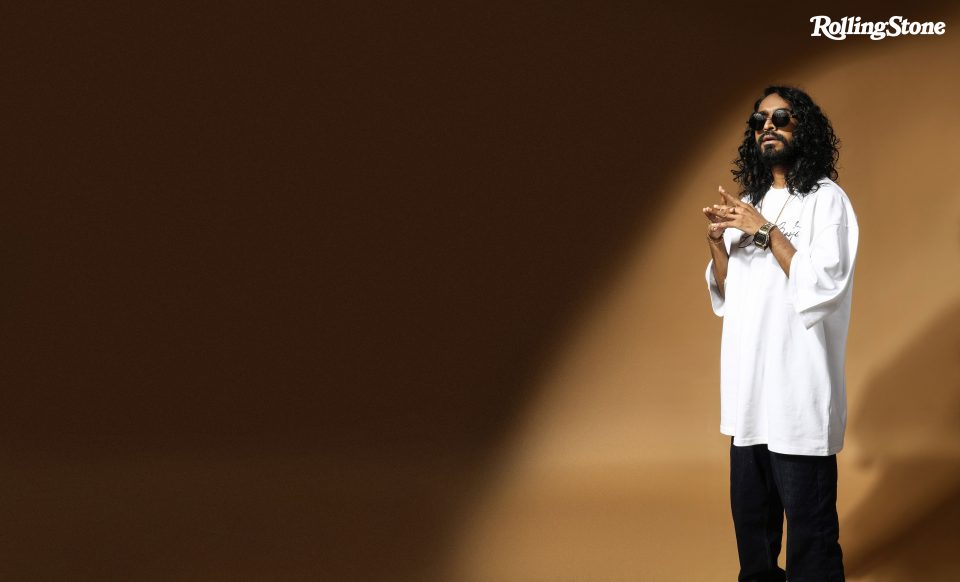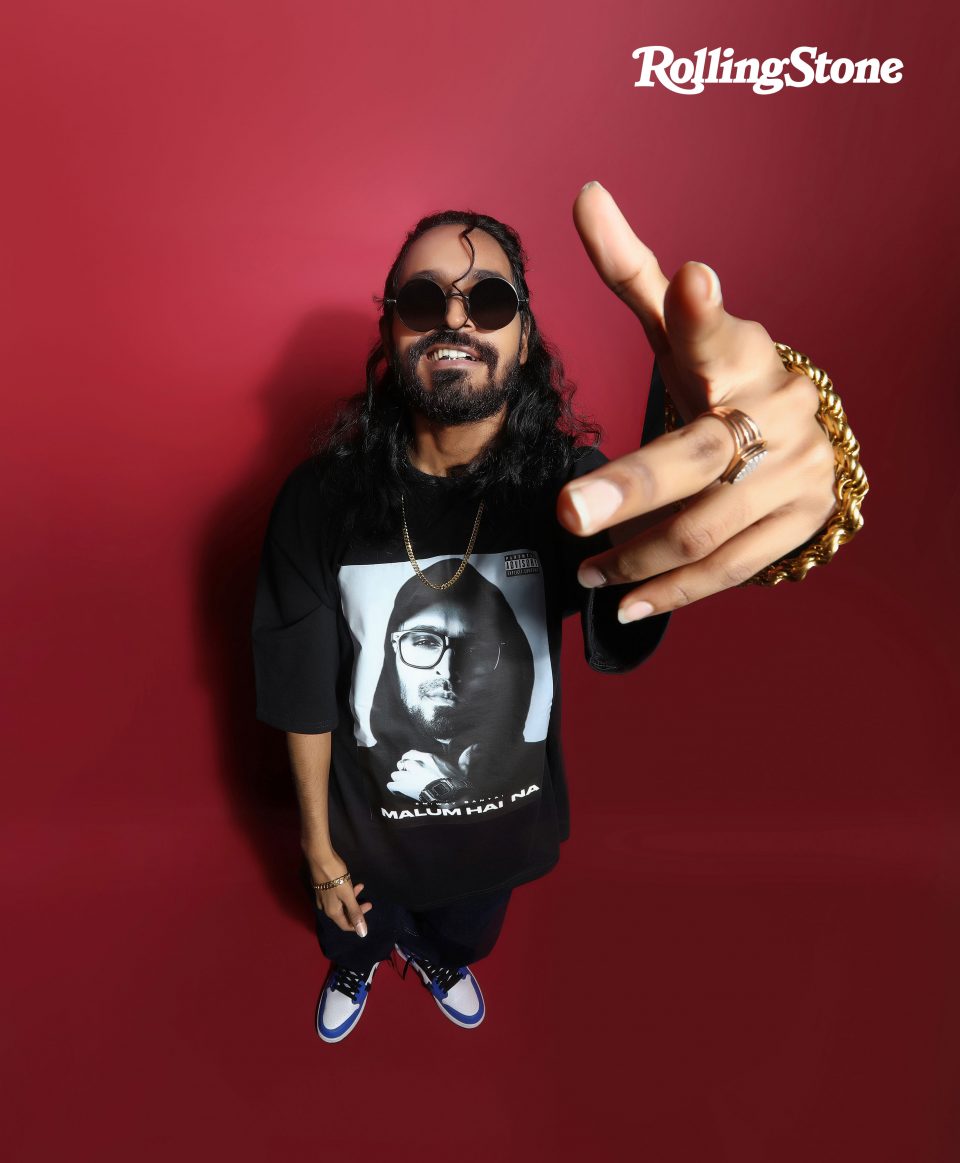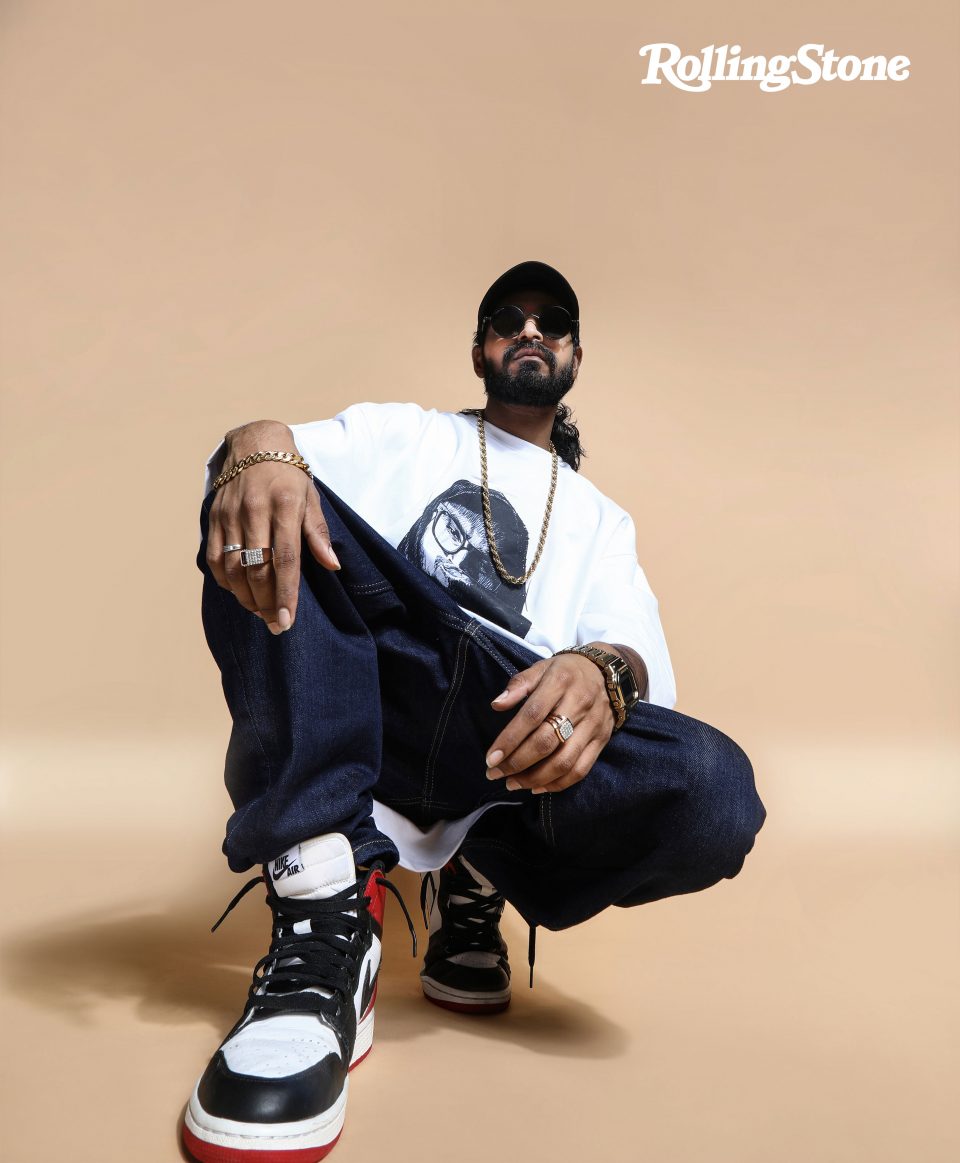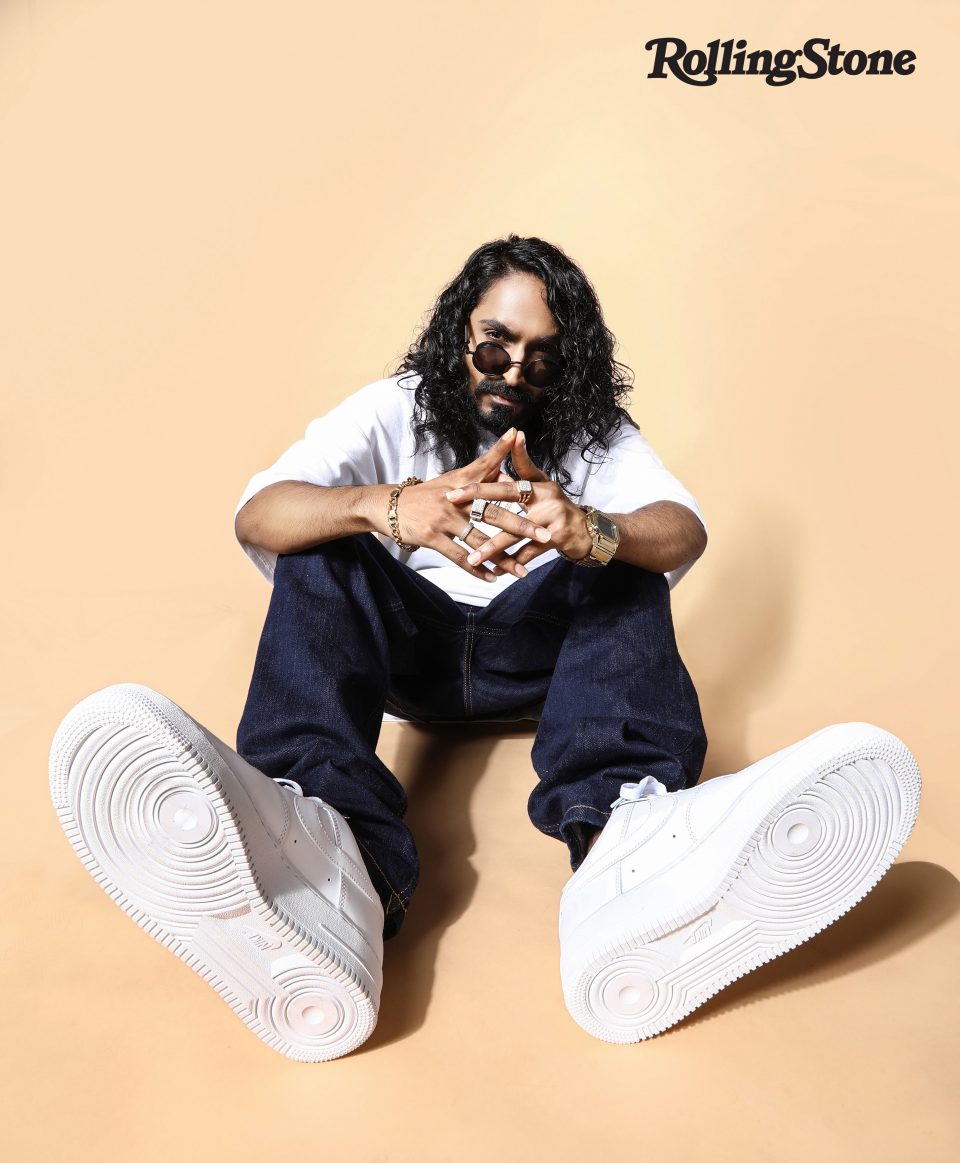COVER STORY: The Rise and Rise of Emiway Bantai
How the Mumbai rapper cracked social media and tackled naysayers to become a viral sensation

Our October 2021 cover features the viral hip-hop artist Emiway Bantai. Photo: Adsto LIVE, Amey Ghatge.
Emiway Bantai occupies a distinct space in Indian hip-hop. In a little over eight years, the social media magnate and multilingual rapper (Emiway spits bars in Hindi, English, Marathi and Tamil) has turned into a phenomenon: the Emiway Bantai insignia stands for a veritable viral hit or nothing — with views well into the billions and counting!
While his debut English track “Glint Lock (feat. Minta)” — released in 2013 when he was 18 — failed to make much of a dent, his 2014 single “Aur Bantai” and particularly, the 2019 drop “Machayenge” (which went viral on the now denaturalized TikTok) captured the attention of a global audience, making Emiway an accidental digital star and a household name. Now, an artist-entrepreneur heading the Mumbai-based label Bantai Records, he reveals how he cracked the code.
The making of Emiway Bantai

Like most borderline millennial Indians, the 1995-born Emiway’s first brush with hip-hop was rapper Eminem’s empowering 2010 anthem, “Not Afraid.” Nary an inch of Mohammed Bilal Shaikh urf Emiway Bantai’s hair had strayed from his oil-slicked scalp, that the rapper — now associated with a raging, bedraggled mane that meets slick, street-styled ensembles and many-hued killer kicks — began to think of life ahead of being an ‘average’ pupil.
In school, Emiway tried to keep up with his teacher’s lessons, while at home, he took to the Internet to learn more about the gift of the Bronx — hip-hop. The music of Eminem and Lil Wayne left an indent on the young Mumbaikar’s psyche and their names became one half of Mohammed’s moniker. Two years after his maiden meeting with hip-hop — a time during which Emiway wrote his SSC examinations and went on to begin college — “Glint Lock” was dropped and out emerged Emiway Bantai.
The cover art for the single featured Emiway hunched on the balls of his feet, chequered sneakers flush with the terracotta pavement tiles that are ubiquitous in his city. He poses in front of the open shutters of Navi Mumbai’s IMX Studio, the same town now home to his own label, Bantai Records. The nascently mustachioed rapper sports a short crop of hair and stares off into the distance, resolute. We get a sense of Emiway’s purpose; lines that are also echoed in his 2021 track “Hai Tu Kaun”: “Shukriya jisne mujhe sign karne se kiya tha mana/ Utna hi hard independent artist main bana (To those who refused to sign me, thank you. It lead me to become a successful independent artist.)”
There was potential, if not promise, in his debut; early strains of the spitfire Emiway we hear today. Three releases later — wherein one can hear heavy influences of Eminem (“Yeh Meri Zindagi”), hitmaker Pitbull (“Tap On The Floor”) and American rockers Linkin Park (“F.O.U.R. Square”), he dropped the seminal single “Aur Bantai” in 2014.
Consistency is the name of the game
“Consistency is one of the biggest reasons why I have reached here. It’s like going to the gym.”
— Emiway Bantai
“It’s like going to the gym; you start slow, but you keep going on consistently and you keep getting better,” says Emiway. The key to his seemingly sudden success in 2014 was consistency. Averaging a release every three months, the rapper had slowly secured a sizable subscriber base on YouTube where he dropped his singles. “You have got to do the exact same hustle. You might feel low at times, but it’s a mandatory part of this process. Believe in yourself before anyone else does, and just keep getting better,” he says. This steady stream eventually propelled Emiway to the status of a rapper on the rise, an ascent he would peak by the end of the decade with viral hits such as “Machayenge” and “Samajh Mein Aaya Kya?”

The Emiway Bantai formula on social media!
The rapper’s chart-toppers boast more than 300M+ views (Emiway Bantai’s cumulative YouTube imprint is well into the billions with a massive 16.4M subscriber base), but he claims his fame was a fluke. “My fame on social media was accidental, supported by the love of music lovers and my loyal followers #BantaiKiPublic. There is no specific method or formula to this thing.”
“I believe I am the voice of the people. Being an entrepreneur has an advantage as it opens up my vision and avenues.”
— Emiway Bantai
Emiway Bantai believes he’s the voice of the people. He’s dominated YouTube and streaming as an independent artist, boasting collaborations with Seattle hip-hop heavyweight Macklemore (“Firse Machayenge Remix ”) as well as celebrated Jamaican cricketer and musician Chris Gayle (“Jamaica to India”), amassing gargantuan numbers on every release. There’s no one raking in the views quite like Emiway. “As an independent artist, I am grateful to be pulling off great numbers across channels,” he says. In a digital-first climate where an artist’s social media imprint predicts the footfall at their concerts, as well as their prospects for translating their art into a sustainable business model for legacy and longevity, Emiway’s success is a case study in making each view count; he’s after all, India’s own indefatigable bastian of hip-hop virality.

Awards, beef and finally a label
Amidst big beef (his battles with native hip-hop frontrunners Raftaar and Divine are well documented), bigger numbers and fissured acclaim (critics haven’t been so kind to Emiway’s artistry), he’s even managed to cut through the noise and start his own label Bantai Records, launched earlier this year.
“I love my work and I love to own it…Bantai Records aims at providing our artists with the services I needed while growing as an artist,” says the rapper.
Emiway’s label is hardly the only independent player in India’s rapidly expanding hip-hop field. Divine’s Gully Gang, Sez On The Beat’s (the man popularly credited with shaping the sound of Indian hip-hop) THE MVMNT, Raftaar’s Kalamkaar, Ranveer Singh and Navzar Eranee’s IncInk, and Mo Joshi and Uday Kapur’s Azadi Records are some of the pacesetters that come to mind when tracing the key movers in the genre’s native landscape.
But the birth of Bantai Records signals a time in Indian hip-hop when an artist helming their own art on a larger stage and wielding their conglomerates for collective prestige is becoming less of a rarity and more of the norm — a welcome chapter in Indian’s languishing (up till 2019) history of hip-hop that has previously lacked direction and strategic appeal. As for his own label, Emiway is looking to break the dam and share with budding artists what he once didn’t have access to: the prowess of a team and the compelling entity of choice.

He says, “Most of the labels just want to own you and control your art; that’s not what I like, and that doesn’t happen at Bantai Records. I give our artists complete freedom to decide what they want to release, when and where – [whether via] label or their personal channel.” Handpicked by Emiway himself, Bantai Records is home to rising artists such as Thoratt, Minta, Meme Machine, Hellac, Loka, Swaalina, Tony James and Young Galib. “I started my own label to keep it open to all aspiring artists hustling in the Indian music scene,” adds Emiway Bantai.
Being an artist-entrepreneur has broadened Emiway’s vision and avenues of being and operation. He subversively (and inadvertently) even settles a beef with his take on big label musicians. “I don’t feel artists who are signed with other labels are sell-outs. I feel everyone has the right to decide the path they want to take, and I always respect the decision anyone takes for themselves,” he says. If the lyrics of his 2021 track “Malum Hai Na (Intro)” are anything to go by — Aur jo hate faila rele/ Unke liye apne dil se maafi hain/ Peace out! (To those spreading hate, I forgive them in my heart. Peace out!) — we think the scores on all showdowns just might finally be settled… we’ll be on the lookout!
Emiway also doesn’t view himself as the sole flagbearer of Indian hip-hop; he is one part of the whole scene. The rapper weighs in on his place in the genre’s native history: “My album (Malum Hai Na) and commercial songs like ‘Machayenge’ and ‘Firse Machayenge’ got Indian hip-hop to the charts. My beef situation gained popularity across the world — which I never planned,” he says. “Overall, I would credit myself for my impact on representing Indian hip-hop. However, I would not say that it was me alone. There have been other artists, in this journey, who have joined the hustle to bring weight to Indian hip-hop.”
A pandemic of pondering, a fearless future
Emiway Bantai is no longer the same artist we were introduced to on “Aur Bantai” and yet, he isn’t all that indistinguishable from his “Machayenge” machismo either. But he’s gone on to reveal on the record, under all that braggadocio, his layers; exploring vulnerability on tracks like the hip-hop ballad “Momma” and humanity on the aggressively introspective “Jawab De.” He’s actively challenging naysayers to make a dent in his armor; this rapper, it seems, will accept the hits only if it leads to evolution.
Through all your milestones, if you had to map a timeline (in years: 2013, 2014… 2021) of your journey, how would you tell people your story — from discovering Eminem to releasing “Glint Lock” to your first viral video to now, launching your own label and mentoring the future of hip-hop?
I started from the bottom in 2013, and eight years down the line, here I am representing Indian hip-hop as an independent artist on the YouTube hoarding at Times Square. I was highly inspired by Eminem and Lil Wayne, hence the name Emiway came into being. It was an adventurous journey and being an independent artist, I understand the hustle that goes behind [it]. Therefore, I started my own label to keep it open to all aspiring artists hustling in the Indian music scene.
As a hip-hop artist who is also a social media magnate, how do you feel about artists turning into content creators, and do you think the formula to your success has been your prowess as both?
Yes, it is very true that artists nowadays are turning into content creators. I believe every artist has their own ways. However, my journey has always been focused on my music. My fame on social media was accidental, supported by the love of music lovers and my loyal followers #BantaiKiPublic.
Please take us into the chapters of your life that shaped and defined your hip-hop sound? Also, how has Mumbai, as a city, impacted your music?
My father brought me to Mumbai from Bengaluru when I was about three years old. I grew up in the slang culture of my hood, Antop Hill. Here, especially my college life has been the most impactful as I learned about the streets, thoughts and the people. The Mumbai slang is very liked and followed by the whole country and around the world, which gives power to my music.
The journey to your debut record has been eight years in the making. What does Malum Hai Na stand for, and what does it mean to have an album out in the world as one of the most viral independent Indian hip-hop artists?
I’ve been concentrating on writing and creating the music that I wanted to put out. For eight years, I had been releasing singles. My audience was looking forward to an album. My story is already well known to my audience and hence I say “Malum Hai Na (You Know, Right?)” which translates the same idea in Hindi. Hence, the album resonates with who I am and what I want to say. I am thankful for the support of my fans, #BantaiKiPublic, for the success of this album. As an independent artist, I am grateful to pull off great numbers across channels for my very first album.
As an artist who can speak in Hindi, Marathi, Tamil and English, what place do you think you hold in India’s diverse hip-hop landscape, and what does it mean for you to represent these linguistic expanses?

It is definitely an advantage to know multiple languages in a multicultural country. It acts as a window to different cultures to connect with a wider audience. My first song [was] called “F.O.U.R. Square” with Minta, representing Marathi, English, Tamil and Hindi. I feel hip-hop should have no language barrier.
How would you describe Emiway Bantai, the artist and entrepreneur, today?
As an artist, I believe I am the voice of the people. Being an entrepreneur has an advantage as it opens up my vision and avenues. However, I strongly believe that as an artist I cannot describe myself in a single word.
“I am open to Bollywood, but the value it gives should match my vision.”
— Emiway Bantai
How do you envision your future — do you see yourself merging with the mainstream and adapting to Bollywood or do you wish to remain independent and set up Bantai Records as a beacon for Indian hip-hop artists?
For an artist, their art is very valuable. I’ve been offered multiple Bollywood films since I started, however, my vision has not resonated with them yet. I am open to Bollywood, but the value it gives should match my vision.
Do you think you’ve received due credit for your contribution in Indian hip-hop breaking out into the mainstream? Do you think people are confused about who the real torchbearers of Indian hip-hop really are — which artists or people would you credit with this historic contribution alongside yourself?
It has not been a decade yet, however, how much I have ever worked for hip-hop has been very impactful for representing India. My album (Malum Hai Na) and commercial songs like “Machayenge” and “Firse Machayenge” got Indian hip-hop to the charts. My beef situation gained popularity across the world, which I never planned. Overall, I would credit myself for my impact on representing Indian hip-hop. However, I would not say that it was me alone. There have been other artists in the journey who have joined the hustle to bring weight to Indian hip-hop.
You’ve taken a very conscious stance to own your work. Tell us about how and why you set up Bantai Records, and what do you think of hip-hop artists who are signed to big music labels (are they sell-outs?)?
Definitely, I love my work and I love to own it. I started Bantai Records because… the kind of support I always wanted as a growing artist, I never found a label good enough to cater to that. Bantai Records aims at providing our artists with the services I needed while growing as an artist. Most of the labels just want to own you and control your art. That’s not what I like and that doesn’t happen at Bantai Records. I give our artists complete freedom to decide what they want to release, when and where – [via the] label or their personal channel. Also, I don’t feel artists who are signed with other labels are sell-outs. I feel everyone has the right to decide the path they want to take, and I always respect the decision anyone takes for themselves.
What advice would you give to rising and beginner hip-hop artists; how can they crack the code and make their hip-hop go global?
What I feel is that there is no specific method or formula to this thing. The only key is to do what you really love and not try to sound like someone else. Consistency is one of the biggest reasons why I have reached here. It’s like going to the gym; you start slow, but you keep going on consistently, and you keep getting better and [in] shape. You got to do the exact same hustle. Just be consistent. You might feel low at times, but it’s a mandatory part of this process. Believe in yourself before anyone else does, and just keep getting better.
How has the pandemic changed and impacted your artistry?
The pandemic has been a very difficult time for every single one of us. It has made a lot of us think about what’s the real purpose of our lives. It made me reflect on myself and learn from a lot of things and a lot of mistakes that I might have done. I’ve got to spend some real quality time with my family and friends, the people who always supported me. I have made a lot of fresh music during this whole pandemic and one can definitely tell the difference in my style of writing and composing music now, as compared to before the pandemic.
What’s next for you, Emiway Bantai? What’s the future of Indian hip-hop?
I have no idea about the future of Indian hip-hop or even myself. All I know is that I’ll be dropping some crazy music along with the artists on my label Bantai Records. I am nobody to decide the future of Indian hip-hop. Good music will always win.
Art Director: Tanvi Joel
Brand Director: Tulsi Bavishi
Executive Editor: Nirmika Singh
Photographer: Adsto LIVE, Amey Ghatge
Stylist: SWABAE
Wardrobe by: EB



